Security Implementation in SAN
Traditional FC SANs enjoy an inherent security advantage over IP-based networks. An FC SAN is configured as an isolated private environment with fewer nodes than an IP network. Consequently, FC SANs impose fewer security threats. However, this scenario has changed with converged network, storage consolidation, driving rapid growth and necessitating designs for large, complex SANs that span multiple sites across the enterprise. Today, no single comprehensive security solution is available for FC SANs. Many FC SAN security mechanisms have evolved from their counterpart in IP networking, thereby bringing in matured security solutions.
Fibre Channel Security Protocol (FC-SP) standards (T11 standards), published in 2006, align security mechanisms and algorithms between IP and FC interconnects. These standards describe protocols used to implement security measures in a FC fabric, among fabric elements and N_Ports within the fabric. They also include guidelines for authenticating FC entities, setting up session keys, negotiating the parameters required to ensure frame-by-frame integrity and confidentiality, and establishing and distributing policies across an FC fabric.
LUN masking and zoning, security in FC switch port, switch-wide and fabric-wide access control, and logical partitioning of a fabric (Virtual SAN) are the most commonly used SAN security methods. A stronger variant of LUN masking may sometimes be offered whereby masking can be done on the basis of source FC address. It offers a mechanism to lock down the FC address of a given node port to its WWN.
Securing FC Switch Ports
Apart from zoning and LUN masking, additional security mechanisms, such as port binding, port lockdown, port lockout, and persistent port disable, can be implemented on switch ports.

Switch-wide and Fabric-wide Access Control
As organizations grow their SANs locally or over longer distances, there is a greater need to effectively manage SAN security. Network security can be configured on the FC switch by using access control lists (ACLs) and on the fabric by using fabric binding.
ACLs incorporate the device connection control and switch connection control policies. The device connection control policy specifies which HBAs and storage ports can be connected to a particular switch, preventing unauthorized devices from accessing it. Similarly, the switch connection control policy specifies which switches are allowed to be connected to a particular switch, preventing unauthorized switches from joining it.
Fabric binding prevents an unauthorized switch from joining any existing switch in the fabric. It ensures that authorized membership data exists on every switch and any attempt to connect any switch in the fabric by using an ISL causes the fabric to segment.
Role-based access control provides additional security to a SAN by preventing unauthorized activity on the fabric for management operations. It enables the security administrator to assign roles to users that explicitly specify privileges or access rights after logging into the fabric. For example, the zone admin role can modify the zones on the fabric, whereas a basic user may view only fabric-related information, such as port types and logged-in nodes.
Logical Partitioning of a Fabric: VSAN
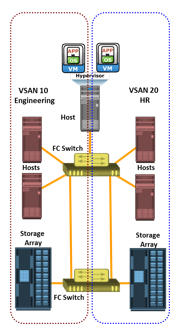 VSANs enable the creation of multiple logical SANs over a common physical SAN. They provide the capability to build larger consolidated fabrics and still maintain the required security and isolation between them. Figure depicts logical partitioning of a fabric using VSAN.
VSANs enable the creation of multiple logical SANs over a common physical SAN. They provide the capability to build larger consolidated fabrics and still maintain the required security and isolation between them. Figure depicts logical partitioning of a fabric using VSAN.
The SAN administrator can create distinct VSANs by populating each of them with switch ports. In the example, the switch ports are distributed over two VSANs: 10 and 20—for the Engineering and HR divisions, respectively. Although they share physical switching gear with other divisions, they can be managed individually as standalone fabrics. Zoning should be done for each VSAN to secure the entire physical SAN. Each managed VSAN can have only one active zone set at a time.
VSANs minimize the impact of fabric wide disruptive events because management and control traffic on the SAN—which may include RSCNs, zone set activation events, and more—does not traverse VSAN boundaries. Therefore, VSANs are a cost-effective alternative for building isolated physical fabrics. They contribute to information availability and security by isolating fabric events and providing authorization control within a single fabric.
SAN Security Architecture: Defense-in-Depth
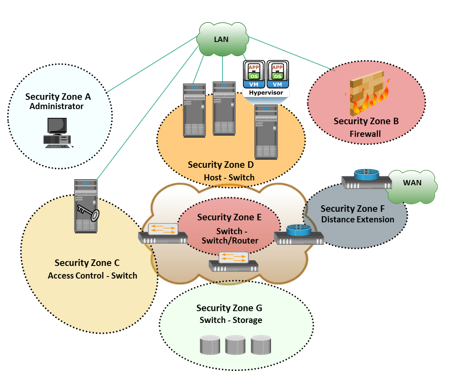
Storage networking environments are a potential target for unauthorized access, theft, and misuse because of the vastness and complexity of these environments. Therefore, security strategies are based on the defense in depth concept, which recommends multiple integrated layers of security. This ensures that the failure of one security control will not compromise the assets under protection. Figure illustrates various levels (zones) of a storage networking environment that must be secured. FC SANs not only suffer from certain risks and vulnerabilities that are unique, but also share common security problems associated with physical security and remote administrative access. In addition to implementing SAN-specific security measures, organizations must simultaneously leverage other security implementations in the enterprise.
Comprehensive list of protection strategies that must be implemented in various security zones are listed below:
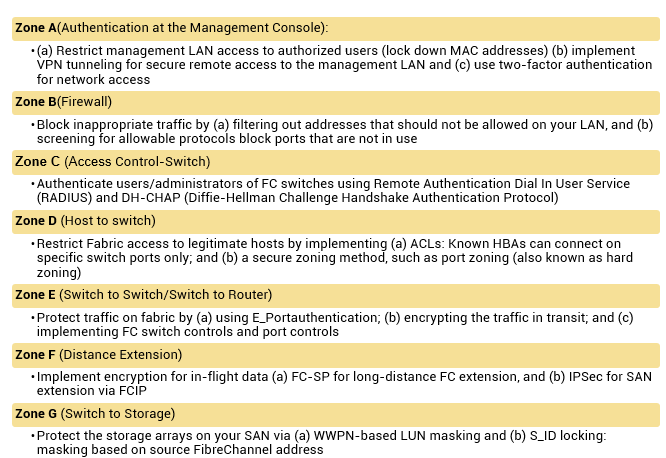
Security Implementation in NAS
NAS is open to multiple exploits, including viruses, worms, unauthorized access, snooping, and data tampering. Various security mechanisms are implemented in NAS to secure data and the storage networking infrastructure.
Permissions and ACLs form the first level of protection to NAS resources by restricting accessibility and sharing. These permissions are deployed over and above the default behaviors and attributes associated with files and folders. In addition, various other authentication and authorization mechanisms, such as Kerberos and directory services, are implemented to verify the identity of network users and define their privileges. Similarly, firewalls protect the storage infrastructure from unauthorized access and malicious attacks.
NAS File Sharing: Windows ACLs
Windows supports two types of ACLs: discretionary access control lists (DACLs) and system access control lists (SACLs). The DACL, commonly referred to as the ACL, that determines access control. The SACL determines what accesses need to be audited if auditing is enabled.
In addition to these ACLs, Windows also supports the concept of object ownership. The owner of an object has hard-coded rights to that object, and these rights do not need to be explicitly granted in the SACL. The owner, SACL, and DACL are all statically held as attributes of each object. Windows also offers the functionality to inherit permissions, which allows the child objects existing within a parent object to automatically inherit the ACLs of the parent object.
ACLs are also applied to directory objects known as security identifiers (SIDs). These are automatically generated by a Windows server or domain when a user or group is created, and they are abstracted from the user. In this way, though a user may identify his login ID as “User1,” it is simply a textual representation of the true SID, which is used by the underlying operating system. Internal processes in Windows refer to an account's SID rather than the account's username or group name while granting access to an object. ACLs are set by using the standard Windows Explorer GUI but can also be configured with CLI commands or other third-party tools.
NAS File Sharing: UNIX Permissions
For the UNIX operating system, a user is an abstraction that denotes a logical entity for assignment of ownership and operation privileges for the system. A user can be either a person or a system operation. A UNIX system is only aware of the privileges of the user to perform specific operations on the system and identifies each user by a user ID (UID) and a username, regardless of whether it is a person, a system operation, or a device.
In UNIX, users can be organized into one or more groups. The concept of group serves the purpose to assign sets of privileges for a given resource and sharing them among many users that need them. For example, a group of people working on one project may need the same permissions for a set of files.
UNIX permissions specify the operations that can be performed by any ownership relation with respect to a file. In simpler terms, these permissions specify what the owner can do, what the owner group can do, and what everyone else can do with the file. For any given ownership relation, three bits are used to specify access permissions. The first bit denotes read (r) access, the second bit denotes write (w) access, and the third bit denotes execute (x) access. Because UNIX defines three ownership relations (Owner, Group, and All), a triplet (defining the access permission) is required for each ownership relationship, resulting in nine bits. Each bit can be either set or clear. When displayed, a set bit is marked by its corresponding operation letter (r, w, or x), a clear bit is denoted by a dash (-), and all are put in a row, such as rwxr-xr-x. In this example, the owner can do anything with the file, but group owners and the rest of the world can read or execute only. When displayed, a character denoting the mode of the file may precede this nine-bit pattern. For example, if the file is a directory, it is denoted as “d”; and if it is a link, it is denoted as “l.”
Authentication and Authorization
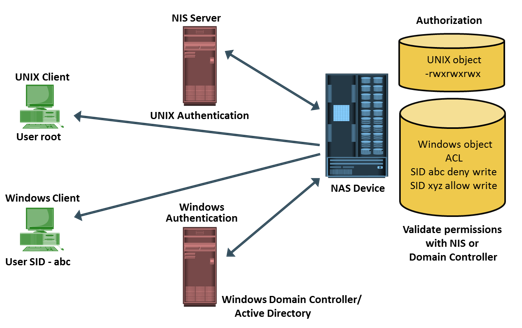
In a file-sharing environment, NAS devices use standard file-sharing protocols, NFS and CIFS. Therefore, authentication and authorization are implemented and supported on NAS devices in the same way as in a UNIX or Windows file-sharing environment.
Authentication requires verifying the identity of a network user and therefore involves a login credential lookup on a Network Information System (NIS) server in a UNIX environment. Similarly, a Windows client is authenticated by a Windows domain controller that houses the Active Directory. The Active Directory uses LDAP to access information about network objects in the directory and Kerberos for network security. NAS devices use the same authentication techniques to validate network user credentials. Figure on the slide depicts the authentication process in a NAS environment.
Authorization defines user privileges in a network. The authorization techniques for UNIX users and Windows users are quite different. UNIX files use mode bits to define access rights granted to owners, groups, and other users, whereas Windows uses an ACL to allow or deny specific rights to a particular user for a particular file.
Although NAS devices support both of these methodologies for UNIX and Windows users, complexities arise when UNIX and Windows users access and share the same data. If the NAS device supports multiple protocols, the integrity of both permission methodologies must be maintained. NAS device vendors provide a method of mapping UNIX permissions to Windows and vice versa, so a multiprotocol environment can be supported.
Kerberos – Network Authentication Protocol
Kerberos is a network authentication protocol, which is designed to provide strong authentication for client/server applications by using secret-key cryptography. It uses cryptography so that a client and server can prove their identity to each other across an insecure network connection. After the client and server have proven their identities, they can choose to encrypt all their communications to ensure privacy and data integrity.
In Kerberos, authentications occur between clients and servers. The client gets a ticket for a service and the server decrypts this ticket by using its secret key. Any entity, user, or host that gets a service ticket for a Kerberos service is called a Kerberos client. The term Kerberos server generally refers to the Key Distribution Center (KDC). The KDC implements the Authentication Service (AS) and the Ticket Granting Service (TGS). The KDC has a copy of every password associated with every principal, so it is absolutely vital that the KDC remain secure. In Kerberos, users and servers for which a secret key is stored in the KDC database are known as principals.
Kerberos Authorization
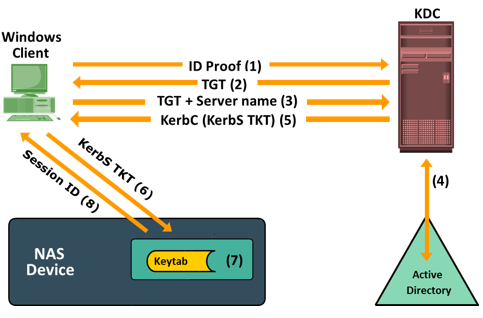
The Kerberos authentication process shown in figure, includes the following steps:
- The user logs on to the workstation in the Active Directory domain (or forest) using an ID and a password. The client computer sends a request to the AS running on the KDC for a Kerberos ticket. The KDC verifies the user’s login information from Active Directory.
- The KDC responds with an encrypted Ticket Granting Ticket (TGT) and an encrypted session key. TGT has a limited validity period. TGT can be decrypted only by the KDC, and the client can decrypt only the session key.
- When the client requests a service from a server, it sends a request, consisting of the previously generated TGT, encrypted with the session key and the resource information to the KDC.
- The KDC checks the permissions in Active Directory and ensures that the user is authorized to use that service.
- The KDC returns a service ticket to the client. This service ticket contains fields addressed to the client and to the server hosting the service.
- The client then sends the service ticket to the server that houses the required resources.
- The server, in this case the NAS device, decrypts the server portion of the ticket and stores the information in a keytabfile. As long as the client’s Kerberos ticket is valid, this authorization process does not need to be repeated. The server automatically allows the client to access the appropriate resources.
- A client-server session is now established. The server returns a session ID to the client, which tracks the client activity, such as file locking, as long as the session is active.
Network Layer Firewalls

Because NAS devices utilize the IP protocol stack, they are vulnerable to various attacks initiated through the public IP network. Network layer firewalls are implemented in NAS environments to protect the NAS devices from these security threats. These network-layer firewalls can examine network packets and compare them to a set of configured security rules. Packets that are not authorized by a security rule are dropped and not allowed to continue to the destination. Rules can be established based on a source address (network or host), a destination address (network or host), a port, or a combination of those factors (source IP, destination IP, and port number). The effectiveness of a firewall depends on how robust and extensive the security rules are. A loosely defined rule set can increase the probability of a security breach.
A demilitarized zone (DMZ) is commonly used in networking environments. A DMZ provides a means to secure internal assets while allowing Internet-based access to various resources. In a DMZ environment, servers that need to be accessed through the Internet are placed between two sets of firewalls. Application-specific ports, such as HTTP or FTP, are allowed through the firewall to the DMZ servers. However, no Internet-based traffic is allowed to penetrate the second set of firewalls and gain access to the internal network. The servers in the DMZ may or may not be allowed to communicate with internal resources. In such a setup, the server in the DMZ is an Internet-facing web application accessing data stored on a NAS device, which may be located on the internal private network. A secure design would serve only data to internal and external applications through the DMZ.
Securing FC Switch Ports
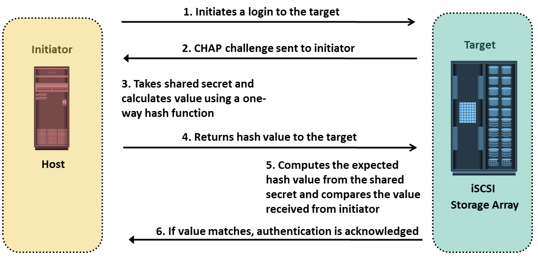
The Challenge-Handshake Authentication Protocol (CHAP) is a basic authentication mechanism that has been widely adopted by network devices and hosts. CHAP provides a method for initiators and targets to authenticate each other by utilizing a secret code or password. CHAP secrets are usually random secrets of 12 to 128 characters. The secret is never exchanged directly over the communication channel; rather, a one-way hash function converts it into a hash value, which is then exchanged. A hash function, using the MD5 algorithm, transforms data in such a way that the result is unique and cannot be changed back to its original form. Figure on the slide depicts the CHAP authentication process.
If the initiator requires reverse CHAP authentication, the initiator authenticates the target by using the same procedure. The CHAP secret must be configured on the initiator and the target. A CHAP entry, composed of the name of a node and the secret associated with the node, is maintained by the target and the initiator.
The same steps are executed in a two-way CHAP authentication scenario. After these steps are completed, the initiator authenticates the target. If both authentication steps succeed, then data access is allowed. CHAP is often used because it is a fairly simple protocol to implement and can be implemented across a number of disparate systems.
Securing IPSAN with iSNS Discovery Domains
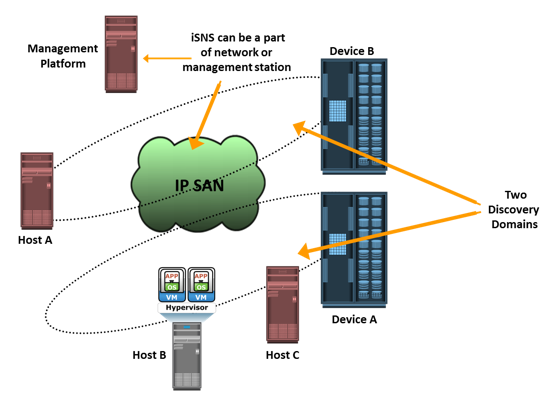
iSNS discovery domains function in the same way as FC zones. Discovery domains provide functional groupings of devices in an IP-SAN. For devices to communicate with one another, they must be configured in the same discovery domain. State change notifications (SCNs) inform the iSNS server when devices are added to or removed from a discovery domain.
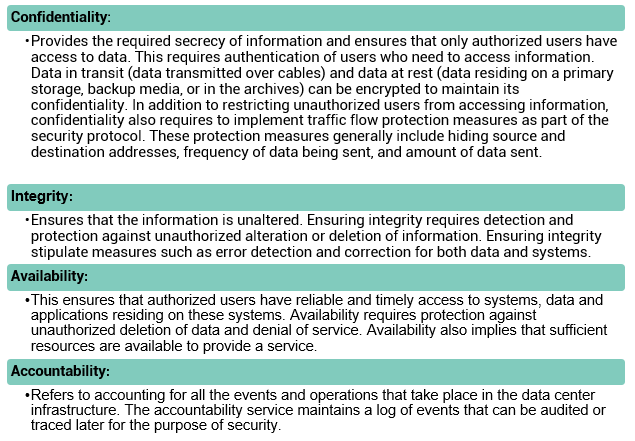
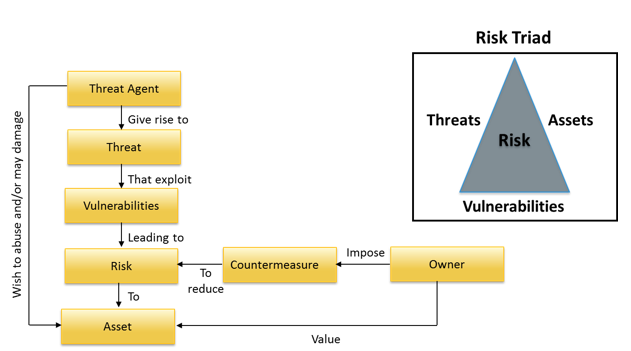


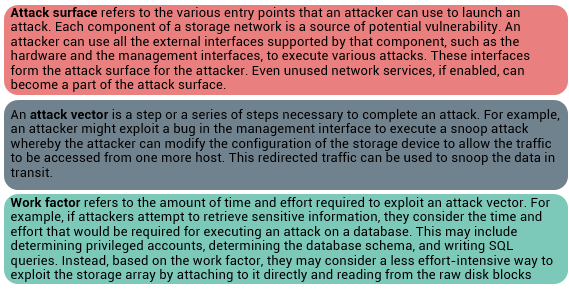
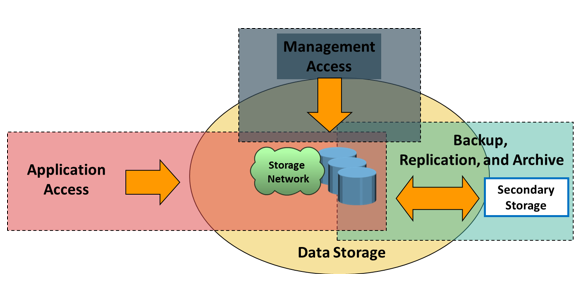


 VSANs enable the creation of multiple logical SANs over a common physical SAN. They provide the capability to build larger consolidated fabrics and still maintain the required security and isolation between them. Figure depicts logical partitioning of a fabric using VSAN.
VSANs enable the creation of multiple logical SANs over a common physical SAN. They provide the capability to build larger consolidated fabrics and still maintain the required security and isolation between them. Figure depicts logical partitioning of a fabric using VSAN. 





